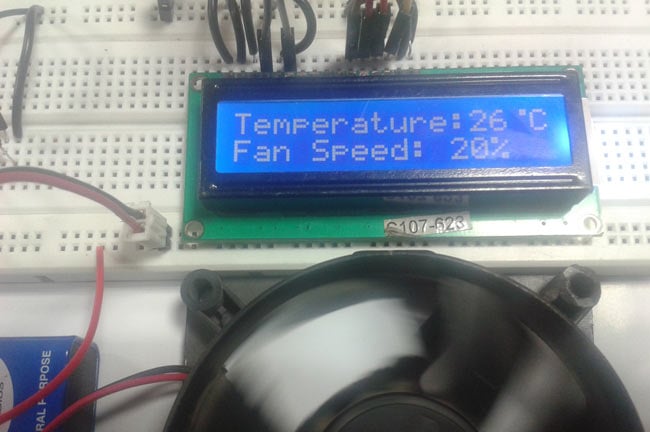Automatic Temperature Controlled Fan Using Arduino

Mar 24, 2018 - In this Arduino based project, we are going to control DC fan speed according to the room temperature and show these parameter changes on a 16x2 LCD display. It is accomplished by the data communications between Arduino, LCD, DHT11 sensor Module and DC fan that is controlled by using PWM.
This application is simple just by using temperature sensor LM35 with an arduino kit to control a fan and change its speed with respect to the temperature read by the micro-controller which in this case is the arduino kit. The temperature sensor LM35 is connected with the arduino with an analog input pin A0 (the temperature is an analog signal), while the fan is connected with a PWM (Pulse Width Modulation) pin 6 which controls the speed of the fan with respect to the output temperature using a function map in the arduino IDE. The Components needed: 1. Temperature Sensor LM35 3. 1K Resistor 4.

Diode 1N4007 5. Dc Motor or a simple DC fan 6. NPN transistor BC547 7.
Lotin yozuvida ruscha so'zlarni qidirish Lug'at bo'yicha taklif va mulohazalaringizni kutib qolamiz. Mobil ilovamizni baholashni (★★★★★) unutmang! ***** This Russian-Uzbek and Uzbek-Russian dictionary is intended to help Russian or Uzbek language learners. Dictionary includes more than 30K rows and about 50K words. EN-RU-UZ lug’at dasturi-bazasida 20000 dan ortiq so’z zaxirasi mavjud. Dasturni ishlatishda masalan Inglizcha so’zni yozib izlash buyrug’i tanlanadi va sizga inglizcha so’zning ham ruscha va o’zbek tilidagi ma’nosi ko’rsatilib beriladi. Ruscha uzbekcha lugat and play. Ushbu 'O‘zbekcha-ruscha lug‘at' ta’lim rus tilida olib boriladigan maktablarning boshlang‘ich sinf o‘quvchilari uchun mo‘ljallangan.Ushbu lug‘atning leksik materialidan keyin kiritilgan so‘zlar, frazeologik oborotlar va tasvirlanayotgan hodisalarni tushunish va esda saqlab qolishga yordam beruvchi qiziqarli illustratsiyalar berilgan. Inglizcha-O'zbekcha, O'zbekcha-Inglizcha Lug'at: 45000 Dan Ortiq So'z Va Ibora Akbar Xolmuradov, Ravshan Azizov G'afur G'ulom nomidagi nashriyot-matbaa ijodiy uyi, 2007 - English language - 503 pages. Muallif Mavzu: Ruscha-o'zbekcha lug'at (2 jildlik) ( 39224 marta o'qilgan) 0 Foydalanuvchilar va 1 Mehmon ushbu mavzuni kuzatishmoqda. Forum Administratori.
A voltage source with 12Volts 8. Hook up wires 9. Optional: voltage source socket.
Schematic •using the NPN transistor BC547 here as a buffer to isolate the first circuit which is the connection to the arduino and the other one with the fan. •using an inverted PN-junction parallel to the fan to prevent moving current in the opposite direction and make damage to the arduino kit. •using a PWM pin is to modulate the signal given to the fan with respect to the read temperature and by using the map function to control the fan speed. •it is important to put in consideration that the input voltage for the temp sensor is 5v from the arduino itself, and the 12volt voltage given to the motor or fan must be from an external voltage source, in this case we collect all the GND together weather the GND of the arduino and the external voltage source. You might've had this question answered, but for others who are curious - the fan is an inductive load, and the diode therefore serves as a 'flyback diode'. Technically, the fan's motor develops a magnetic field in order to spin.
When the fan suddenly loses power (when you turn it off at the switch), it tries to 'feed itself' using the motor's collapsing magnetic field as its source, instead of the original source - which is now missing. Depending on the magnitude of this field, the inductor creates a negaitve potential where it was once positive, and the inductive load tries to essentially 'force' the voltage across the power switch, creating an arc. This is dangerous for the circuit. A diode is therefore placed across the motor such that the intended source won't bypass the fan when operating, and the inductor will 'power itself down' PROPERLY (until it dies) when the fan is turned off. Hope this helps:).
Shim regulator oborotov ventilyatora pechki. C: Users mshaf AppData Local Temp arduino_modified_sketch_444937 sketch_sep26a.ino:5:102: fatal error: dht.h: No such file or directory #include //Library for dht11 Temperature and Humidity sensor (Download from Link in article) ^ compilation terminated. Multiple libraries were found for 'IRremote.h' Used: C: Users mshaf Documents Arduino libraries IRremote-2.2.3 Not used: C: Users mshaf Documents Arduino libraries Arduino-IRremote-master Not used: C: Program Files (x86) Arduino libraries RobotIRremote exit status 1 Error compiling for board Arduino/Genuino Mega or Mega 2560. Hi, I followed all the instructions but im having a problem with the irsend, the ir can not opent the AC once reaches above 27C as per your program says: if ((Measured_temp >= Desired_temperature+4) && AC == false) //If AC is off and measured Temp is greater than Desired Temp { irsend.sendRaw(ACon, sizeof(ACon) / sizeof(ACon[0]), khz); delay(2000); //Send Signal to Turn On the AC delay(2000); irsend.sendRaw(Temp27, sizeof(Temp27) / sizeof(Temp27[0]), khz); //Send signal to set 27*C AC_Temp = 27; AC=true; •.